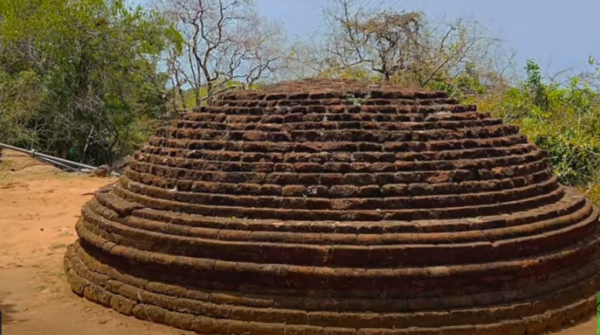“Girihandu Seya” – first Buddhist stupa? – By Arundathie Abeysinghe

 Girihandu Seya (“Seya” meaning stupa or dagoba) also known as “Nithupathpana Vihara” is an ancient Buddhist Temple in *Thiriyaya in *Trincomalee. Girihandu Seya is considered as the first Buddhist Stupa in Sri Lanka, believed to have been constructed by two seafaring merchants *Tapassu and *Bhalluka. Names of the two merchant bothers are recorded on a rock inscription in the temple premises. According to the inscription, Girihandu Seya was constructed by the guilds of merchants named “Trapassuka” and “Vallika”, Their names were written as “Tapassu” and “Bhalluka” in Sinhala chronicles.
Girihandu Seya (“Seya” meaning stupa or dagoba) also known as “Nithupathpana Vihara” is an ancient Buddhist Temple in *Thiriyaya in *Trincomalee. Girihandu Seya is considered as the first Buddhist Stupa in Sri Lanka, believed to have been constructed by two seafaring merchants *Tapassu and *Bhalluka. Names of the two merchant bothers are recorded on a rock inscription in the temple premises. According to the inscription, Girihandu Seya was constructed by the guilds of merchants named “Trapassuka” and “Vallika”, Their names were written as “Tapassu” and “Bhalluka” in Sinhala chronicles.
Situated on a small hillock near the sea coast, approximately 47 kilometers (29 miles) towards north of Trincomalee, the stupa of the Temple has been enlarged during the 8th century A.D. The Vatadage (literally meaning circular relic house or shrine) covers the stupa with concentric circles of stone pillars, almost similar to Thuparama and Lankarama stupas at Anuradhapura. Similar to typical architectural features of ancient temples in Sri Lanka, vatadage of the Temple is constructed of stone. This is a circular platform open to four directions and can be accessed by a flight of steps with guard stones (Muragala) and balustrades (Korawak Gala).
The short prose inscription in the Temple premises, 8th century Sanskrit epigraph written in Sanskrit, records an account of two sea-faring merchants. Majority of the inscription is occupied by a long eulogy of a shrine known as “Girikandi Chaitya” founded by the guilds of merchants named Trapussaka and Vallika. The record ends with a Buddhist formula about the transitoriness of mundane objects.
According to Pujavaliya (a Sinhala religious text) written in 1266 A.D, two merchants Tapassu and Bhalluka had offered the first dana (alms giving) to the Buddha who delivered his first sermon in the 8th week after his *Enlightenment. After the sermon, the merchants had requested the Buddha for something to worship. They had received “Sacred Kesha Datu” (lock of sacred hair relic). These two merchants traveled to different parts in the region (for business purposes) and came to Sri Lanka also. According to chronicles, one day, they had stayed in Thiriyaya and placed the sacred relic container on the summit of a rock and had gone to the surrounding area for a business purpose. On their arrival, they had found that the container could not be moved from the location and had decided to construct a stupa enshrining sacred hair relic. Later, it had been named as “Girihadu Seya.” Thereafter, a Buddhist Temple had been constructed at the location. Scholars are of the view that this is the first Buddhist Stupa constructed in Sri Lanka as there are no records of stupas before. The location has been abandoned for several centuries engulfed by thick forest. Restoration of the stupa was carried out in 1950’s.
The stupa in the Temple is highly venerated by devotees, as it is believed to contain sacred hair relics of the Buddha.
- Arhat – The term “Arhat” refers to a pious Buddhist monk who has gained insight into the true nature of existence and has achieved *Nirvana.
- Enlightenment – In Buddhism, Enlightenment is when a Buddhist finds the truth about life and stops being reborn as he/she has reached *Nirvana.
- Nirvana – Refers to a release from the cycle of death and rebirth, the ultimate spiritual goal of Buddhism.
- Sotapanna – One who has reached the first stage of the four levels of awakening recognized in Buddhism. “Sotapanna” literally means “one who entered (apanna) the stream (sota), translated into English Language as “Stream Enterer”, “Stream Entrant” or “Stream Winner”. Here, stream refers to the Noble Eight-fold Path which needs to be cultivated in order to attain *Enlightenment.
- Tapassu and Bhalluka – Traditionally regarded as the first disciples of the Buddha and according to the Theragatha Commentary, Tapassu and Bhalluka were brothers, sons of a caravan leader of Pokkharavati. They had visited the Buddha at Rajagaha, his first disciples after Enlightenment. where the Buddha preached to them. After the Buddha’s sermon, Tapassu, had attained the stage of *“sotapanna”. Later, Bhalluka had entered the Bhikkhu Order and become an *arhat.
- Tiriyaya – (known as “Thiriyai” in Tamil – derived from the Tamil word “thiri,” meaning wick is an ancient Tamil village, an international emporium with an old sea port that existed since 6th century BCE.
- Trincomalee – Situated on one of the world’s finest natural and beautiful deep-water harbors, Trincomalee is a port city located on the northeastern coast of Sri Lanka. Trincomalee also known as “Gokanna” or “Gokarna” is located on the east coast of the island overlooking Trincomalee Harbor, 237 kilometers (147 miles) north-east of Colombo. For over two millennia, Trincomalee has been one of the major areas where Sri Lankan Tamils have resided. Trincomalee has attracted seafarers, traders as well as pilgrims from Europe, Australasia, East Asia, Africa, China and the Middle East from ancient periods. With a population of approximately 126000 people and located in the Eastern Province of Sri Lanka, Trincomalee is also a major tourist attraction and a port city visited by large numbers of local and foreign tourists, annually.
Strategic significance of Trincomalee Harbor – By Arundathie Abeysinghe – July 15, 2021
https://www.elanka.com.au/strategic-significance-of-trincomalee-harbor-by-arundathie-abeysinghe/







